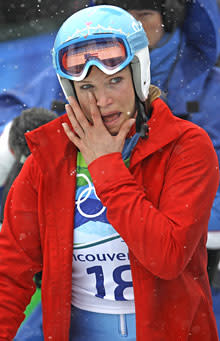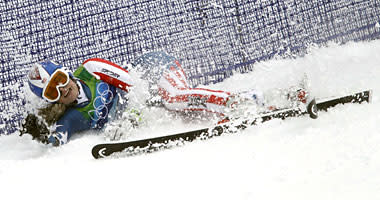Reality bites U.S. Alpine team
Follow Charles Robinson on Twitter at @YahooSportsOLY
WHISTLER, British Columbia – Julia Mancuso came off the course Wednesday, dropped her head into her hands, and started crying. Little did she know, America's newfound ski aficionados were right there with her.
Six wondrous days – the kind of thing that reels in new fans and garners a rare spotlight for Alpine skiing – have come to a crunching halt for the United States. Lindsey Vonn crashed in the giant slalom; Mancuso wept after a re-start flag destroyed her momentum; weather postponed the remainder of the race until Thursday; and all the steam built by the U.S. Ski Team came to a disappointing but fairly common standstill.
"This," skiing veterans will tell you, "is a typical day for the sport."
And for most ski-ignorant Americans, that's precisely the problem.
When U.S. skiers become frustrated with Americans and wonder why there hasn't been a renaissance of homegrown popularity in their sport, all you need to do is look at the last 48 hours. Take a moment and see what the "typical" days of the Alpine skiing have done for the U.S. team.
Two days after Sports Illustrated blessed the U.S. Alpine team with a sweeping cover shot of four of its athletes draped in eight medals, those same four skiers all suffered frustrations. Bode Miller skipped a gate in the men's giant slalom and didn't finish on Tuesday. Vonn crashed in the women's giant slalom and broke her right pinky finger on Wednesday. Mancuso got off to blazing start in the same race, but was forced into a restart mid-course by Vonn's crash. When she finally got on the course a second time, she fell more than a full second behind the leader, burst into tears in the finish and directed an expletive toward race officials on her Twitter page. Even Andrew Weibrecht, who took bronzed in the super-G, went home Wednesday with a shoulder battered from falling in the super combined.
Just like that, the U.S. Ski and Snowboard Association (USSA) saw a major public relations opportunity hook a ski and slam head first into the reality of its sport. Americans who tuned in after seeing the Sports Illustrated cover – and there's no doubt it sparked some new interest – were greeted by crashes, mistakes, tears and drama. And those aren't great selling points for a sport seeking non-Olympic traction.
But it sheds some light on why this sport suffers in the eyes of Americans. The Alpine program is perpetually locked in an all-or-nothing Olympic gamble that centers on a precious few. Had Miller & Co. not come through so brilliantly in the first six races, few outside the mainstream ski culture would have noticed. But they did, and it opened an opportunity for American skiing to gain some momentum and transcend the cycle of grabbing the spotlight once every four years.
And then comes the last 48 hours, where stars fall and fail, weather forces a race postponement and the casual fan starts to turn away. The Sports Illustrated cover, only 48 hours old, loses just a little bit of the gloss for those who were just being introduced to the sport.
It makes you think about the bonds that USSA has failed to build. Make no mistake, all American Olympic skiers are at a distinct disadvantage when it comes to the love of their sport. They make their living on a World Cup tour that is beloved in Europe but visits the United States only twice – once for the men and once for the women – and then vanishes into the mountainous folds of Northern Europe. That's why when the Olympics come around, the U.S. media spends an inordinate amount of time and energy trying to explain to Americans exactly how big a deal it is for Miller and Vonn to have been crowned overall World Cup champions.
We spell it out, try to make a comparison Americans can understand, and they typically respond with a yawn. Why? Because they don't see it on their own turf. And USSA does a terrible job of making their skiers relevant and publicized in the four years between each Winter Games.
As Yahoo! Sports skiing analyst Bryon Friedman put it succinctly on Wednesday, "It's impossible for the American public to get exposure to ski racing when there isn't any ski racing in America. There's virtually none. There's nothing for them to latch onto."
Which is why over the next four years, you'll hear very little about any of the stars – even Miller and Vonn – and nothing about some of the younger, hungrier skiers. Unless it's something tied to their endorsements, you'll hear little about Vonn or Miller's World Cup exploits. You might hear a few things about Mancuso's "Kiss My Tiara" underwear line, but even that's doubtful. And Weibrecht, well, unless he invents a better iPod, the mainstream is going to have a hard time distinguishing him from a line of German sausages at the grocery store.
So here we sit, rolling off one of the most impressive Olympic runs in U.S. Alpine history, but dealing with the typical frustrations of the sport and realizing that, until the 2014 Games in Sochi, Russia, this success isn't likely to have a legs. A sad reality is that as Americans, we crave success and consistency in our sports just like we crave our burgers at the drive-thru window: hot, fast and ever-present. We're simply not patient enough to wait for the five-discipline Olympic meal every four years.
And that's too bad. It puts a great Olympic run and a great sport at a disadvantage. So the next time you see Mancuso shedding a tear, think of the bigger picture. After this great run ends in a few days, there will still be plenty to cry about.


